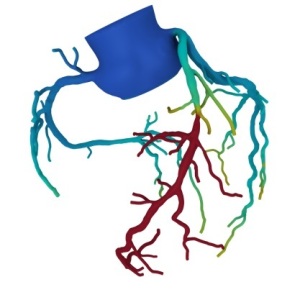by
Lisa Chamoff, Contributing Reporter | March 20, 2017

HeartFlow FFRct result demonstrating
coronary artery disease
WASHINGTON, D.C. — Siemens Healthineers and HeartFlow have struck an agreement that brings together Siemens CT and HeartFlow’s FFRct Analysis technology to diagnose coronary artery disease in a noninvasive way.
The two companies announced the non-exclusive partnership over the weekend at the American College of Cardiology scientific meeting in Washington.
The HeartFlow technology uses data from a coronary CT angiogram to measure fractional flow reserve (FFR), or how much stenosis is impacting blood flow, a measurement that would otherwise be made via coronary catheterization.



Ad Statistics
Times Displayed: 109208
Times Visited: 6638 MIT labs, experts in Multi-Vendor component level repair of: MRI Coils, RF amplifiers, Gradient Amplifiers Contrast Media Injectors. System repairs, sub-assembly repairs, component level repairs, refurbish/calibrate. info@mitlabsusa.com/+1 (305) 470-8013
“Typically, you have to take the patient into the cath lab and do a diagnostic procedure to obtain this FFR measurement,” Matthew Dedman, director of strategic corporate accounts for CT diagnostic imaging at Siemens Healthineers told HCB News. “Now, that measurement can be obtained noninvasively through the HeartFlow FFRct Analysis. It’s a much better clinical pathway to avoid those unnecessary procedures — it’s better for the patient, it saves time, it saves money overall for the health care system.”
Through the partnership, the data from a Siemens CT will be transmitted to HeartFlow over the Siemens’ teamplay cloud. With CT images, the HeartFlow FFRct Analysis creates a 3-D model of the patient’s arteries, using algorithms to simulate blood flow and assess the impact of blockages. Using this analysis, a physician can decide whether or not to move forward with an interventional procedure.
The collaboration between the two companies “will enable a very seamless transmission of the data through our Siemens cloud to HeartFlow and then back by that same mechanism to the hospital,” Dedman said.
“As you can imagine, it’s a major IT hurdle for our customers to establish this additional external connection,” Dedman said. “We already have this established connection through our teamplay cloud. We can overcome IT integration hurdles and HeartFlow just becomes a different module through our teamplay cloud.”
Under the collaboration agreement, customers would purchase a CT from Siemens and enter into a separate contract with HeartFlow. Siemens would then perform the data transmission for the mutual customers.
“Based on the continued promising results coming from their clinical trials, Siemens has absolutely acknowledged this as an emerging technology for the future,” Dedman said. “I think this partnership is a clear indication that we believe this is a better overall clinical pathway for coronary artery disease patients. We’re avoiding sending these patients into the cath lab just to determine they don’t need further intervention with a stent.”

